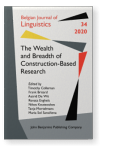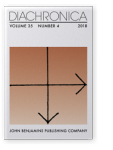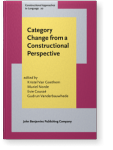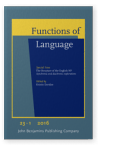Lauren Fonteyn
List of John Benjamins publications for which Lauren Fonteyn plays a role.
Articles
2020 Let’s get into it: Using contextualized embeddings as retrieval tools The Wealth and Breadth of Construction-Based Research, Colleman, Timothy, Frank Brisard, Astrid De Wit, Renata Enghels, Nikos Koutsoukos, Tanja Mortelmans and María Sol Sansiñena (eds.), pp. 66–78 | Article
This squib briefly explores how contextualized embeddings – which are a type of compressed token-based semantic vectors – can be used as semantic retrieval and annotation tools for corpus-based research into constructions. Focusing on embeddings created by the Bidirectional Encoder… read more
2018 Competing motivations in the diachronic nominalization of English gerunds Diachronica 35:4, pp. 487–524 | Article
The present study is an in-depth, corpus-based analysis of the rise and institutionalization of the indefinite nominal gerund in Late Modern English, considering the observed developments in light of their interactions with functionally related constructions. Based on historical data taken from… read more
2018 Chapter 6. Category change in the English gerund: Tangled web or fine-tuned constructional network? Category Change from a Constructional Perspective, Van Goethem, Kristel, Muriel Norde, Evie Coussé and Gudrun Vanderbauwhede (eds.), pp. 149–177 | Chapter
This study considers the diachronic categorial shift from nominal (NG) to verbal gerunds (VG) in Middle English in terms of Langacker’s functional account of noun phrases and clauses as ‘deictic expressions’. The analysis shows that the Middle English gerund was essentially formally nominal but… read more
2016 From nominal to verbal gerunds: A referential typology The Structure of the English NP: Synchronic and diachronic explorations, Davidse, Kristin (ed.), pp. 60–83 | Article
This paper provides a detailed comparison of the referential behaviour of noun phrases and nominal and verbal gerunds from Middle to Late Modern English. It will be shown that in earlier stages of English, nominal and verbal gerunds to a large extent resemble prototypical noun phrases in their… read more



